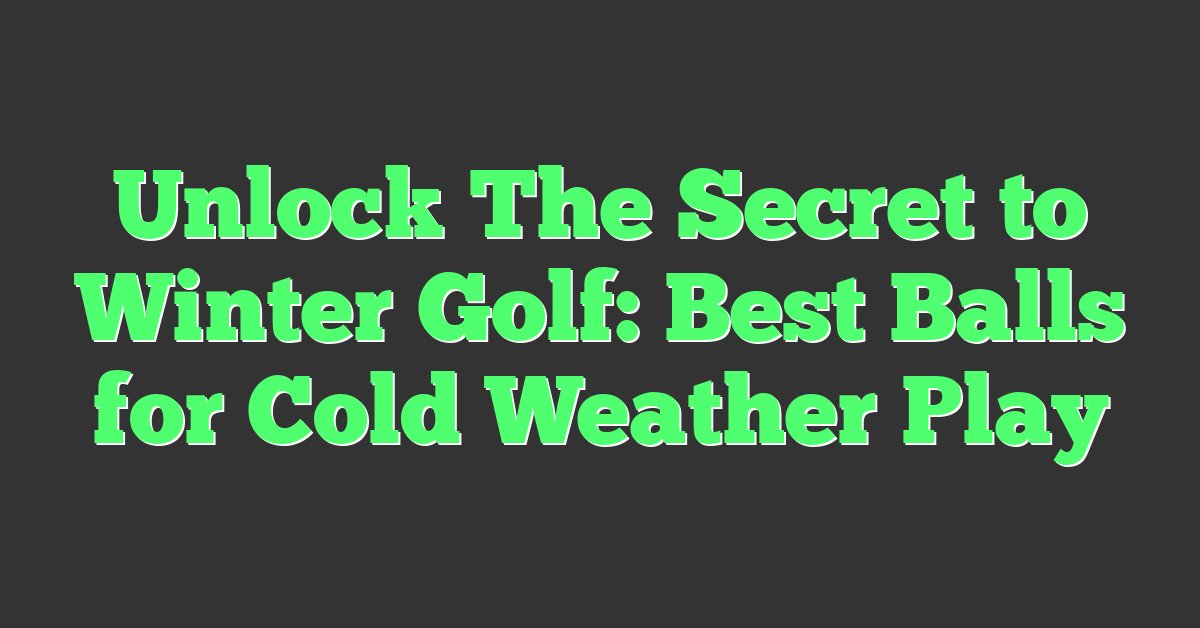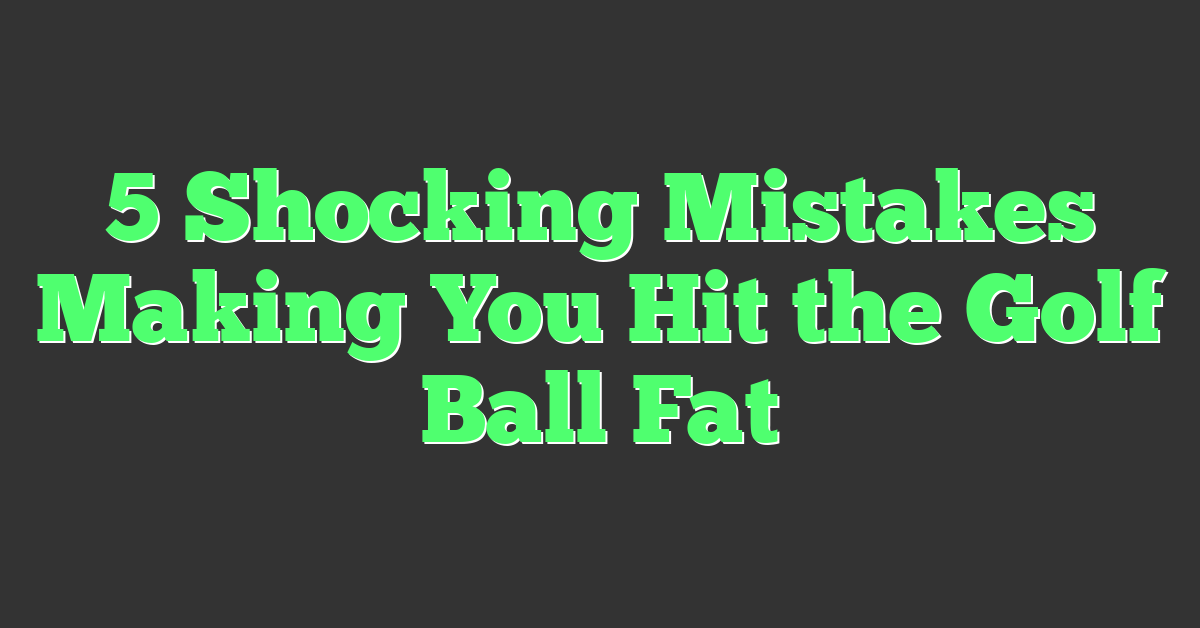When the temperature drops, your golf game doesn’t have to suffer. Choosing the right golf ball can make all the difference when you’re braving the chill to hit the links. Cold weather affects ball performance, and what works in the summer may leave you short on the fairway when it’s cold.

You’re probably wondering what changes you should make to your golf ball selection as the mercury falls. Well, certain balls are designed to perform better in cold conditions, offering you the edge you need. Let’s dive into the world of golf balls and find the perfect match for those chilly rounds.
How Cold Weather Affects Golf Ball Performance
As you dig deeper into the nuances of golf, you’ll find that temperature is a crucial player on the course. It’s not just about the comfort level while you’re swinging the club; it’s about the very behavior of your golf ball. In cold weather, the performance of a golf ball is noticeably different, and understanding these changes can help you adapt.
First and foremost, colder air is denser, which means there’s more resistance against the ball during flight. This resistance can reduce the distance your ball travels. To put it simply, when temperatures drop, so does your ball’s flight distance. Your usual club selection might not get you to the green in cold conditions as it would in milder weather.
The golf ball itself also behaves differently in the cold. The materials it’s made of tend to stiffen, which results in a loss of compression. A ball that’s less compressible has less ability to spring off the clubface, leading to reduced speed and distance. Plus, a stiffer ball will have a lower spin rate, affecting not only how far it goes but how it lands and rolls on the green.
To counteract these effects, you might need to adjust your swing. Opting for a longer club or swinging a bit harder is a common strategy; however, it’s also about selecting a ball that is designed to perform under such conditions. These specialized cold-weather balls are crafted with materials that maintain a better energy transfer despite the cold.
Remember, cold weather golfing isn’t just about battling the elements; it’s about strategic adjustments. Paying attention to details like your ball selection can give you an edge. You want a ball that will respond reliably, even when your breath is visible in the crisp morning air. Look for options specifically marked for cold weather play and don’t shy away from experimenting to see which ball suits your game best.
Understanding the Different Types of Golf Balls
When it comes to cold weather play, recognizing the variety of golf balls available is critical. They’re not all created equal, and different types can significantly impact your performance.
Two-piece golf balls are quite popular. They have a solid rubber core and are designed to maximize distance, a real advantage when you’re up against the dense, cold air that’s sapping your ball’s momentum. The cover is usually made from Surlyn, a material that resists cuts and abrasions well, ensuring longevity.
Multi-layer golf balls have, as you may have guessed, multiple layers. They’re typically aimed at providing a balance between distance and spin control. For those chilled mornings on the fairway, a three-piece ball may offer that extra spin necessary for the green to counteract the rigid ball flight the temperature imposes.
Here you’ll find urethane-covered balls, which really excel at spin control. The softer cover grips the clubface longer, imparting more spin for control around the greens. Just be aware, the softer materials may feel even softer when it’s cold, which can be a bit of a double-edged sword.
Lastly, we have the high-performance balls. These are often four-piece constructions aimed at the serious golfer who wants to fine-tune their game. Each layer is crafted to offer specific benefits, such as soft feel, increased spin, and longer distance. They can be game-changers but remember, low temperatures might not allow you to reap all the benefits these balls can offer.
Key for playing in the cold is to choose a ball that won’t lose too much compression. Low-compression golf balls are ideal as they’ll help counteract the stiffening of the ball’s core.
- Two-piece balls for distance
- Multi-layer for balance and green-side control
- Urethane-covered for spin control
- High-performance for an all-around game
Selecting the right ball can trim strokes off your game, even when your breath is fogging in the crisp morning air. Imagine the satisfaction as you maintain control over your game, even when Mother Nature is trying to throw you off your usual rhythm. Keep experimenting with different balls and pay attention to how your shot’s trajectory changes – that’s how you’ll find the perfect cold-weather companion for your golf bag.
The Best Golf Balls for Cold Weather
When the mercury drops, your choice in a golf ball can mean the difference between a solid round and a frustrating game. Your low-handicap game hinges on equipment that responds consistently, and that’s even more critical in cold weather.
Two-piece balls might be your first choice if distance is your prime concern. They typically have a larger core and a durable, cut-resistant cover which aids in maintaining performance despite the chill. Two brand names stand out for cold-weather play: the Titleist DT TruSoft and the Callaway Supersoft. Both are engineered to deliver exceptional distance and a consistent ball flight when the air is crisp.
If you’re looking for a ball that combines distance with better feel and control, consider the multi-layer balls with a soft cover. Bridgestone’s e6 Soft and Srixon’s Soft Feel are designed to reduce spin on long drives, which can help maintain your distance on cold days. But they still provide the control needed around the green.
The compression rating of a golf ball is a crucial factor. In cold weather, lower compression balls are typically more effective. They compress more easily upon impact, leading to better energy transfer and less loss of distance. Golf balls with compression ratings of 70 or below, such as the Wilson Staff Duo Soft+ and the TaylorMade Soft Response, are particularly suited for chilly conditions.
Golf ball technology evolves constantly, and there are specialty balls crafted for almost every situation. Here’s a quick roundup of what you might consider stocking in your bag when the temperature starts to fall:
- Two-Piece Balls: Titleist DT TruSoft, Callaway Supersoft
- Multi-Layer Balls: Bridgestone e6 Soft, Srixon Soft Feel
- Low Compression Balls: Wilson Staff Duo Soft+, TaylorMade Soft Response
Remember, cold air is denser and can decrease the ball flight. Besides selecting the right golf ball, adjust your game accordingly. Clubbing up and ensuring a smooth, rhythmic swing will also mitigate the cold’s impact on your game. Testing different balls under cold conditions can give you real-world insights to better inform your selection. Keep an eye on how your shots respond to the selected ball and adjust your strategy on the course to maintain your edge.

Factors to Consider when Choosing a Cold Weather Golf Ball
As someone who’s navigated the greens your whole life, you understand that the right equipment can significantly affect your performance. When temperatures drop, golf ball selection becomes yet another crucial aspect of the game to master. Here are some factors you should weigh in on.
Temperature sensitivity is a key attribute in a golf ball. The fact is, cold air is denser, adding more resistance to your ball in flight. This minuscule change means you’re going to need a ball that’s less affected by these conditions. Two-piece construction golf balls usually have a lower compression, which means they are less sensitive to the cold. They remain softer and therefore more responsive when you’re out there in the chill.
Next, consider the compression rating of the ball. Typically, balls with a low compression rating perform better in cooler weather because they require less force to compress. This translates to a better energy transfer from the club to the ball, helping maintain your distance off the tee.
Here’s a quick breakdown of some popular cold weather golf balls and their compression ratings:
| Golf Ball | Compression Rating |
|---|---|
| Wilson Staff Duo Soft+ | Low |
| TaylorMade Soft Response | Low |
| Titleist DT TruSoft | Medium |
| Callaway Supersoft | Low |
| Bridgestone e6 Soft | Medium |
| Srixon Soft Feel | Low-Medium |
While distance is important, don’t forget about the spin characteristics. A ball that provides a consistent and high level of spin can be advantageous on approach shots and around the green, where precision is necessary. Balls like the Bridgestone e6 Soft are designed to give you a balance, offering decent spin without sacrificing too much distance.

Finally, your personal feel preference cannot be overstated. While the technical specs are critical, you’ll also want a ball that feels right. After all, confidence in your equipment is a silent partner to success on the golf course. During the cold months, you might find that your touch and control are slightly altered, so selecting a ball that enhances your feel for the game can help in maintaining a lower score.
Tips for Maximizing Performance in Cold Conditions
Cold conditions on the golf course require a shift in your approach to the game. You’ve got to think strategically about every aspect, from the equipment you use to the way you swing. The key? Keeping everything in motion and understanding the physics at play.
First off, swing adjustments are vital. In cold weather, your muscles are naturally stiffer, and your ball won’t compress as easily. That means you need a slower, more controlled swing. This isn’t about power; it’s about precision. Think of it as easing into your swing rather than trying to force it.
Next, let’s talk layers. You’ve got to stay warm to maintain flexibility. Invest in quality thermal gear that offers mobility and insulation without bulk. Remember, having a full range of motion is crucial for your swing, so avoid anything that restricts your movement.
Grip strength becomes even more important in the cold. Your hands might not feel as responsive, and that’s why a good pair of winter golf gloves can be a game-changer. They should provide a combination of warmth and grip that standard gloves can’t offer in chilly conditions.

Course management is ever important. The ball won’t travel as far in the cold, so club up when you’re in doubt. Estimating yardage in cold weather isn’t just about math; it’s about feel and experience. If the temperature drops, so does the ball’s bounce and roll.
- Consider these tips:
- Use a softer compression ball.
- Execute a smoother tempo.
- Wear appropriate clothing.
- Strengthen your grip.
- Adjust your yardage expectations.
Taking a strategic approach to these conditions will not only improve your comfort but will also keep those scores low. After all, staying in control under tough conditions is what separates good golfers from the greats. Keep your focus on adapting to the environment, and you’ll find yourself conquering the cold-weather rounds with confidence.
Conclusion
So there you have it! You’re now equipped with the knowledge to choose the right golf ball for those chilly days on the course. Remember, it’s not just about the ball, but also how you adapt your game to the conditions. Stay warm, keep your swing controlled, and use your strategic smarts. By doing so, you’ll ensure that the cold doesn’t put a damper on your scorecard. Now grab your clubs, your new favorite cold-weather golf ball, and hit the greens with confidence, no matter the temperature!










